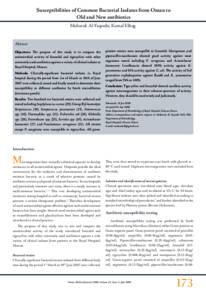Document
Susceptibilities of common bacterial isolates from Oman to old and new antibiotics.
Contributors
Elhag, Kamal., Author
Publisher
Oman Medical Specialty Board.
Gregorian
2008-07
Language
English
English abstract
Objectives: The purpose of this study is to compare the
antimicrobial activity of linezolid and tigecycline with other
commonly used antibiotics against a variety of clinical isolates at
Royal Hospital, Muscat.
Methods: Clinically-significant bacterial isolates in Royal
hospital during the period from 1st of March to 30th of June
2007 were collected, stored and finally tested to determine their
susceptibility to different antibiotics by broth microdilution
(microscan panels).
Results: Two hundred ten bacterial strains were collected and
tested including Staphylococcus aureus (29), Group B ß-haemolytic
Streptococcus (10), Streptococcus pneumoniae (15), Enterococcus
spp. (16), Haemophilus spp. (15), Escherichia coli (26), Klebsiella
spp. (26), Enterobacter spp. (25), Serratia spp. (10), Acinetobacter
baumannii (17) and Pseudomonas aeruginosa (21). All strains
except P. aeuginosa were susceptible to tigecycline. All grampositive strains were susceptible to linezolid. Meropenem and
piperacillin-tazobactam showed good activity against most
organisms tested including P. aeruginosa and Acinetobacter
baumannii. Levofloxacin showed 100% activity against K.
pneumoniae and 61% activity against E. coli. The activity of 3rd
generation cephalosporins against E.coli and K. pneumoniae
ranged from 76% to 100%.
Conclusion: Tigecycline and linezolid showed excellent activity
against microorganisms in their relevant spectrum of activity.
However, they should be used wisely and judiciously.
Member of
Resource URL
Citation
Al-Yaqoubi, Mubarak, & Elhag, Kamal (2008). Susceptibilities of common bacterial isolates from Oman to old and new antibiotics. Oman Medical Journal, 23 (3), 173-178.
Category
Journal articles

